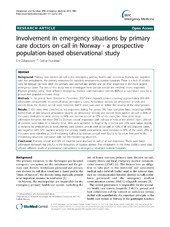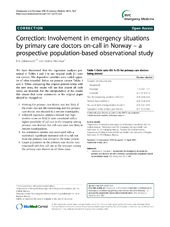| dc.contributor.author | Zakariassen, Erik | en_US |
| dc.contributor.author | Hunskår, Steinar | en_US |
| dc.date.accessioned | 2010-11-19T14:33:55Z | |
| dc.date.available | 2010-11-19T14:33:55Z | |
| dc.date.issued | 2010-03-06 | eng |
| dc.Published | BMC Emergency Medicine 10(5) | en |
| dc.identifier.issn | 1471-227X | |
| dc.identifier.uri | https://hdl.handle.net/1956/4313 | |
| dc.description.abstract | Background: Primary care doctors on-call in the emergency primary health care services in Norway are, together with the ambulances, the primary resources for handling emergencies outside hospitals. There is a lack of reliable data for Norway on how often the primary care doctors are alerted and on their responses in the most urgent emergency cases. The aim of this study was to investigate how doctors on-call are involved in red responses (highest priority), using three different emergency medical communication centres (EMCC) as catchment area for a prospective population-based study. Methods: In the period from October to December 2007 three dispatch centres covering approximately 816 000 inhabitants prospectively recorded all acute emergency cases. Ambulance records, air ambulance records and records from the doctors on-call were collected. NACA score was used to define the severity of the emergencies. Results: 5 105 cases were classified as red responses during the period. We have complete basic recordings (AMIS forms) from all and resaved ambulance records, air ambulance records and records from doctors on-call in 89% of the cases. Ambulances were alerted in 96% and doctors on-call in 47% of the cases, but there were large differences between the three EMCCs. Doctors on-call responded with call-out in 42% of the alerted cases. 28% of all patients were taken to a casualty clinic, 46% were admitted to hospital by a doctor and 24% were taken directly to hospital by ambulances. In total, primary care doctors on-call took active part in 42% of all red response cases, and together with GPs’ daytime activity the primary health care services were involved in 50% of the cases. 29% of the cases were classified as life-threatening. Call-out by doctors on-call were found to be more frequent in lifethreatening situations compared with not life-threatening situations. Conclusion: Doctors on-call and GPs on daytime were involved in half of all red responses. There were large differences between the EMCCs in the frequency of doctors alerted. The inhabitants in the three EMMCs were thus offered different levels of professional competency in emergency situations outside hospitals. | en_US |
| dc.language.iso | eng | eng |
| dc.publisher | BioMed Central | eng |
| dc.rights | Attribution CC BY | eng |
| dc.rights.uri | http://creativecommons.org/licenses/by/2.0/ | eng |
| dc.title | Involvement in emergency situations by primary care doctors on-call in Norway - a prospective population-based observational study | en_US |
| dc.type | Peer reviewed | |
| dc.type | Journal article | |
| dc.description.version | publishedVersion | en_US |
| dc.rights.holder | Copyright BMJ Publishing Group and the British Association for Accident and Emergencey Medicine | |
| dc.rights.holder | BMJ Publishing Group and the British Association for Accident and Emergencey Medicine | |
| dc.identifier.doi | https://doi.org/10.1136/emj.2007.054338 | |
| dc.identifier.cristin | 350132 | |
| dc.subject.nsi | VDP::Medisinske Fag: 700 | nob |


